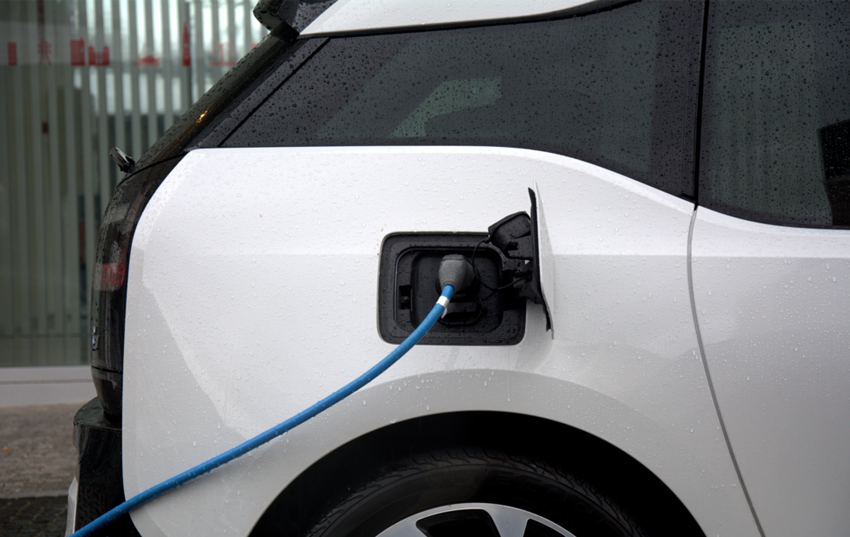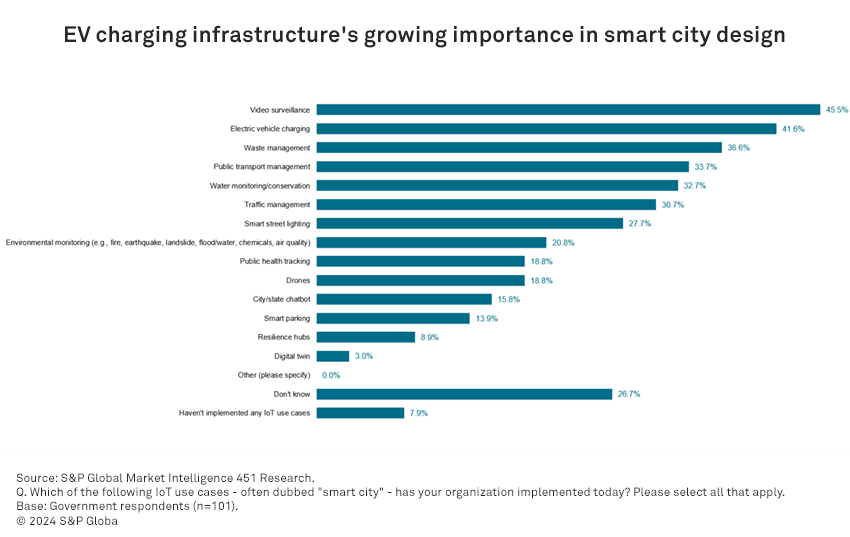
Source: Miguel Sotomayor/Moment via Getty Images.
In a recent survey conducted by the 451 Research, a part of S&P Global Market Intelligence, electric vehicle (EV) charging emerged as the second-most-deployed IoT smart city use case application in the US. With the rising adoption of technologies like vehicle-to-everything for traffic management and the growing number of electric vehicles, government regulations are prioritizing carbon neutrality. As a result, the demand for faster, accessible, equitable, and user-friendly charging stations is increasing. The deployment of information technology (IT) and operational technology (OT) infrastructure to support widespread EV charging presents a significant opportunity for technology vendors to contribute to a greener future.
The path forward for current barriers to EV adoption
The survey findings indicate that the availability of EV charging infrastructure is the second-most significant barrier to EV adoption, following vehicle price. While home-based charging remains prevalent, public charging is gaining importance due to the widespread adoption of EVs. In response, governments have implemented regulations to improve the EV charging network.
In Europe, the Alternative Fuels Infrastructure Regulation establishes mandatory targets for charging infrastructure, including distance-based targets, charging power output, and payment systems. Government incentives, such as France’s Advenir program, have encouraged the installation of EV chargers, targeting companies and communities investing in publicly available chargers. European governments have also provided grants, tax credits, and funding to support EV infrastructure development.
In the US, the Biden-Harris Administration has announced significant grants to expand the EV charging network, with a goal of achieving at least 500,000 publicly available chargers by 2030. The Charging and Fueling Infrastructure Program complements the National Electric Vehicle Infrastructure program, focusing on high-speed EV chargers along highways. States like Ohio and New York have already made progress in establishing new charging stations.

Overview of electric vehicle charging technologies
EV charging technologies include both AC (alternating current) and DC (direct current) charging, each serving distinct purposes. AC charging, commonly used at homes and workplaces, is slower but cost-effective, while DC charging offers rapid charging, ideal for public stations and long trips.
Wired charging is the most prevalent method, categorized into three levels:
- Level 1: Uses a standard 120-V outlet, providing 1.3 to 2.4 kW.
- Level 2: Utilizes a 240-V outlet, offering 7 to 19 kW.
- Level 3: Known as DC fast charging, operates at up to 480 V, with power outputs reaching 350 kW.
Other technologies include smart charging, which optimizes energy use, V2G (vehicle-to-grid) for bidirectional energy flow, and wireless charging, an emerging option that allows for charging without physical connections, including dynamic systems that charge vehicles while in motion. However, wireless systems remain costly and are still being standardized.
Essential standards and requirements for EV charging stations
EV charging stations must adhere to specific installation, operation, and maintenance standards, addressing aspects like the number of ports, connector types, payment options, and customer support. Key requirements for effective EV infrastructure include:
- Interoperability: Stations should support various EV models through standardized connectors and protocols.
- Network connectivity: High-speed connections enable real-time monitoring and updates, utilizing wired LAN, cellular networks, and industrial gateways.
- Public information access: Users should easily find charging station locations, pricing, and accessibility via mapping apps.
- Edge processing: Local computing at chargers manages load balancing, authentication, and user interfaces.
- Cloud solutions: Cloud-based systems enhance functionality, including predictive maintenance.
- Data management: Effective data systems monitor availability and maintenance needs, improving user experience.
- Security: Strong cybersecurity measures are essential for data protection and secure communication.
- Charging software: This simplifies the management of power networks and payment processing.
- Traffic control and signage: These help users locate stations efficiently.
Cities should strategically choose charging station locations based on accessibility and user needs, ensuring a suitable mix of charger types and ongoing maintenance for functionality.
Roles and collaboration in EV charging infrastructure
Companies in the EV charging infrastructure sector fulfill various roles, including:
- Infrastructure firms: Build and maintain charging stations.
- Equipment manufacturers: Produce charging hardware.
- Installation and maintenance providers: Handle the setup and servicing of charging points.
- Charging point operators: Manage charging networks.
- Software providers: Offer payment applications and location services.
Integrating IT and OT for enhanced EV charging solutions
In the evolving EV adoption landscape, collaboration between IT and OT vendors is crucial. This partnership integrates EV charging solutions with smart grid technologies, connecting IT systems (like cloud services and data analytics) with OT systems (such as charging stations and grid management). The advantages include improved efficiency, scalability, reliability, data-driven insights, energy management, and enhanced user experiences, all contributing to a sustainable EV charging ecosystem. The table below highlights some notable IT/OT EV charging partnerships.
The role of EV charging infrastructure in sustainable smart cities
Smart cities can significantly lower emissions and improve air quality by encouraging electric vehicle (EV) adoption and ensuring accessible charging infrastructure. Integrating EV charging with the energy grid allows for better electricity demand management, optimizing energy distribution and reducing grid strain. EVs can also act as energy storage, utilizing excess renewable energy and helping balance the grid during peak times.
Moreover, EV charging infrastructure provides valuable data for informed decision-making, enhancing energy efficiency, infrastructure planning, and transportation systems. Overall, it is a vital element of sustainable smart cities, promoting eco-friendly transportation, grid optimization, economic growth, and a better quality of life for residents.
Want insights on IoT trends delivered to your inbox? Join the 451 Alliance.
Want insights on consumer technology trends delivered to your inbox? Join the 451 Alliance.
This content may be AI-assisted and is composed, reviewed, edited and approved by S&P Global in accordance with our Terms of Service.
